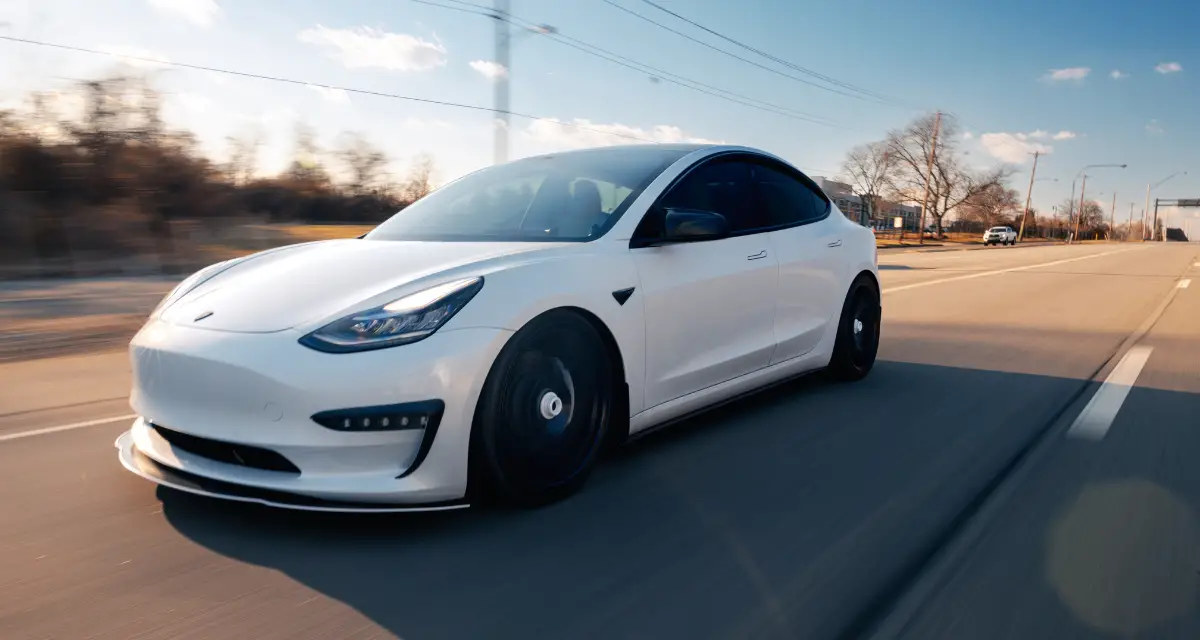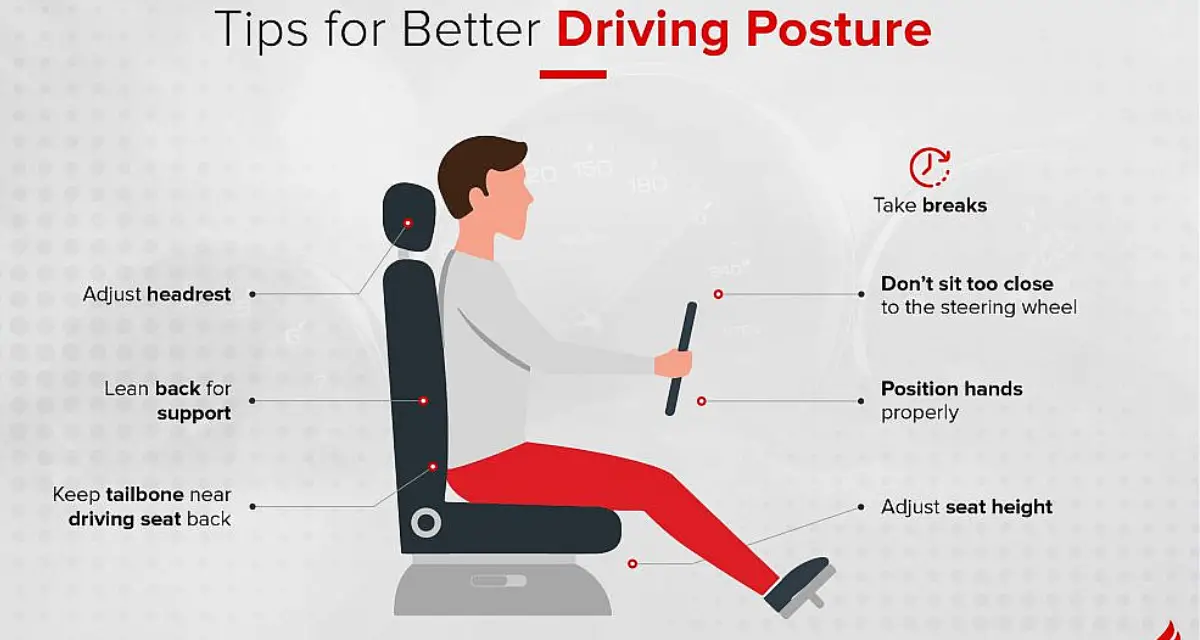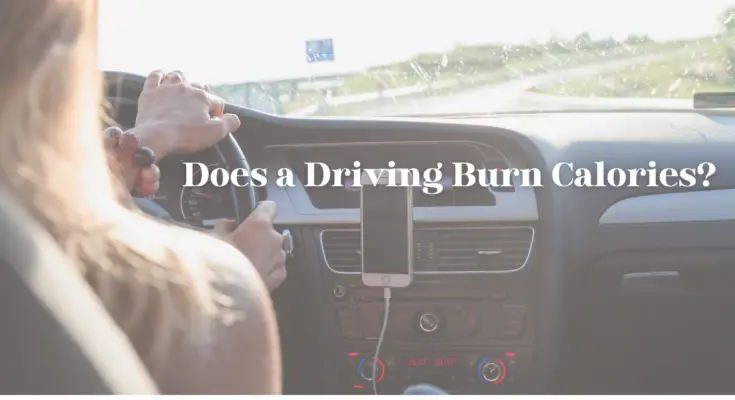In our fast-paced world, where time is precious, many people spend a lot of time commuting. Whether driving to work or school or running errands, the time spent behind the wheel adds up. Are you stuck in traffic and wondering if driving burns calories? Especially for the person who is trying to lose weight.
Although a more physically intensive activity would burn more calories, the average person can burn about 30 calories in 10 minutes while driving. KUDOS to the physical actions required to drive!
You might be surprised to learn that even sitting behind the wheel can burn some fuel – not just the gas kind. Even though driving does not exactly equate to intense exercise, it doesn’t mean a complete lack of calorie burning.
In this article, we’ll delve into the science behind driving and its potential impact on your calorie burning.

How Does a Driving Burn Calories?
Before we delve into the effects of driving specifically, it is crucial to fundamentally grasp how calorie burn works. The human body uses energy in many ways, and one primary source is physical activity. Activities in daily living such as walking, exercising, and even sleeping contribute to the total manager.
Factors such as activity intensity, duration, and body weight influence the number of calories an individual burns. The more complex the activity is and how long it takes, the more calories you use. With this in mind, let us look at the role that driving plays in this equation.
It is well-known that our bodies are constantly humming an internal furnace, even at rest. This metabolic engine – the Basal Metabolic Rate (BMR), burns calories to keep our essential functions going. So, even if you are driving, your body is busy converting oxygen and food into energy that it uses in vital processes such as running organs or keeping a heartbeat.
TIP: The specific effects of driving can vary depending on individual factors like frequency, duration, driving habits, and overall lifestyle.
Beyond BMR: How Many Does a Driving Burn Calories?
But driving adds another dimension to this metabolic landscape. Though not an intense activity, it includes several small movements that involve the workings of your muscles and thus increase your BMR marginally. Here’s how:
- Gripping the Wheel: Holding on to the steering wheel, especially during turns or in bumpy situations, involves your forearms, biceps, and shoulders.
- Pedal Power: Activating your calves, ankles, and thighs does not occur fully when gas or brake pedals are pressed.
- Posture Control: Proper posture when controlling a vehicle entails minor back, neck, and middle muscle changes.
- Mental Engagement: Being in traffic, decision-making, and the need to be alert consume a small amount of energy but keep your brain active.
According to estimates, driving a car consumes about 100 calories per hour. However, the exact caloric burn depends on your weight and how you go.
Driving is estimated to burn about 80 calories per hour for a person weighing around 120 lbs.
- If you weigh around 120 lbs, you might burn approximately 80 calories per hour of driving.
- For a 180 lb person, the calorie burn increases to around 100 calories per hour.
- Aggressive stop-and-go driving, especially in heavy traffic, can increase the calorie burn to 130 calories or more per hour.
How does it add up? On average, the typical driver burns approximately 100 calories over an hour. It may appear to be a small number of calories burned, but it can add up after longer drives. For instance, driving for 3 hours may burn about 300 calories.
NOTE: The number of calories burned will depend upon several factors, including your weight and whether you are the driver or a passenger of the vehicle.
An Additional Factors That Influences Calorie Burn

In other words, driving is a stationary activity. Physical exercises that engage several muscle groups and increase your heart rate require much more movement than sitting behind the wheel. So, it is easy to assume that driving does not burn many calories because of this passive factor. Though this is somewhat true, driving can affect calorie burning in small ways.
1. Calories Burned at Rest
Even at rest, the body will need energy to perform critical functions like breathing, circulation, and regulation of bodily temperature. This is called the Resting Metabolic Rate (RMR). Although your body is not entirely at rest when driving, you use some muscles to control the car. You end up burning more calories than if you are sitting still.
2. Muscle Engagement during Driving
Though driving is a less energetic exercise compared to the more vigorous ones, some muscle groups are still used. When operating the pedals, steering wheel, and gear shift, muscles in the legs, core, and 1rarms are activated. Over time, this may result in a somewhat boosted total calorie burning.
3. Intensity
Heavy periods of driving, such as during rush hour traffic, demand a lot from us physically and burn more calories than simply enjoying leisurely cruising in less congested traffic.
4. Vehicle size
This means that your vehicle determines how much effort is required. For instance, controlling a large truck burns more calories than driving a small sedan since it involves more significant muscular effort in operating and steering the controls.
5. Road conditions
Bumpy, winding roads require more constant adaptations than smooth, straight highways. This can lead to a minor increase in the calorie burn during driving.
6. Body position
good posture burns calories faster than slouching because your core muscles must work hard to maintain upright standing.
7. AC usage
Using the AC would mean that your body works harder to keep its core temperature and consequently burn off more calories.
8. Music
Listening to music that makes you stomp your fingers and move your head can burn more calories than merely resting in silence.
Note: Technological advancements in autonomous vehicles have the potential to mitigate some of the negative effects of driving, but further research and development are needed.
In other words, while driving, as such, burns more calories than sitting, the number of additional burned calories wears heavily on numerous external factors.
Does Sitting in a Car Burn Calories?
A deep dive into setting versus driving illuminates the subtle yet noteworthy differences in calorie burn. This question addresses an exciting nuance in energy expenditure: “Does driving burn more calories than just sitting?
Calorie Burn Sitting vs. Driving
Let’s break down the numbers. When a 120-lb person is resting, their body loses around sixty calories every hour; while steering the wheels of an automobile, this figure rises to eighty per hour—thus showing that getting behind the wheel has added twenty-five more minutes! Similarly, a 180 lb person burns eighty calories per hour sitting and one hundred calories per hour driving with again the twenty–calorie difference.
The Margin of Difference
It may surprise you to learn that the difference in calories burned per hour between driving and sitting is, for most people, somewhere between 20-40. This relatively modest difference means that although driving requires more energy than resting, the real caloric difference is minimal.
Translating the Numbers
In essence, in the time frame of just one hour one hour’s drive, you burn an additional 20-40 calories than when remaining stationary. This is equal to the nutritional value provided by a few pieces of almonds. While not a significant difference, it emphasizes that even seemingly non-active things like driving add to your total calories burned.
Note: Eating and driving is not the best idea, especially when you are eating unhealthy food. Avoid the drive-through. If you know you have a long drive ahead of you, plan accordingly by preparing healthy snacks for the road.
What are the long-term effects of driving?

The long-reaching implications of driving could be physical, psychological, and social or environmental. Here’s a breakdown of some key considerations:
Physical Effects:
Musculoskeletal Issues: A long drive in the car can cause muscle contraction, discomfort, and pain along the neck, back, and shoulder, as well as the legs. In the long run, problems with carpal tunnel syndrome and joints may also be caused by poor posture and repetitive movements.
Obesity and Cardiovascular Disease: Long hours of sitting can lead to obesity, diabetes, and cardiovascular disease. Driving often substitutes physical activity, lowers cardiovascular fitness, and increases blood pressure.
Vision Problems: Hours spent staring at the road strain your eyes and could add to fatigue, headaches, and dry eyes. UV radiations from the windows can also result in cataracts and age-related macular degeneration.
Accidents and Injuries
Driving is a safe activity as long you take proper precautions, but the possibility of an accident or injury will always exist. They can range in severity from minor bumps and bruises to life-altering severe disabilities.
Mental Effects
Anxiety and stress: Can be caused by traffic congestion, aggressive driving, as well as long commutes. Even mental fatigue comes from the necessity to be vigilant and make decisions all the time.
Reduced Cognitive Function: Long-term sitting and lack of physical activity have been found in studies to impact cognitive function, memory, and concentration adversely.
Isolation and Loneliness: Spending several hours in a car alone can cause feelings of isolation and loneliness, particularly for persons who depend on vehicles to perform typically throughout the day.
Environmental Effects
Air Pollution: Cars are major air polluters, and this causes respiratory problems, climate change issues, and environmental devaluation. The more you drive, the worse your effect on air quality is.
Fossil Fuel Dependency: The more we use cars to transport, the greater our dependence on fossil fuels, finite resources with critical environmental effects.
Urban Sprawl: Urban sprawl, land degradation, deforestation, and habitat loss are induced by car dependence.
Societal Effects
Traffic Congestion and Infrastructure Strain: Car use that is on the increase leads to the creation of congested roads, which in turn wastes time, resources, and fuel. It also puts pressure on infrastructure, which needs constant maintenance and the creation of new roads and parking lots.
Accidents and Traffic Deaths: Car accidents are one of the significant causes of injuries, disabilities, and deaths that affect individuals and communities.
Limited Accessibility: People with disabilities, older adults, and those who do not have driving skills may be excluded from society due to their reliance on cars.
In the long run, driving has various implications that must be considered cautiously. Driving is undoubtedly convenient and liberating, but one should also bear in mind its possible drawbacks; thus, it would be beneficial to seek out other sustainable and healthy modes of transportation as often as we can.
Here are some additional points to consider
- The effects of driving are specific to everyone. Still, they might differ depending on the frequency and duration and other factors about an individual, like habits while behind the wheel or their lifestyle in general.
- While autonomous vehicles will likely alleviate some of the negative consequences of operating a car, much additional research and development will be required.
- Promoting more environmentally friendly activities such as walking, cycling, and bus travel will benefit everyone with a cleaner, healthier planet.
And remember that with informed choices and responsible driving habits, we can help reduce the impact of this targeted activity to generate a healthier future for us and our communities.
Remember: Hydrate. The time you spend driving is a good time to drink that bottle of water or two that you have been forgetting to drink all day. Water is not only good for you, but it is also zero calories.
Tips to Overcome Long-term Effects
While driving may not be a significant calorie-burning activity, there are ways to incorporate healthier habits during your commute.
1. Posture and Core Engagement: Maintaining good posture while driving contributes to your overall comfort and engages your core muscles. Sit straight, engage your abdominal muscles, and avoid slouching to maximize muscle activation.
2. Take Active Breaks: If you have a long commute, consider incorporating short breaks to stretch your legs and move around. These breaks provide relief from prolonged sitting and contribute to overall well-being.
3. Mindful Eating on the Go: While not directly related to calorie burning, making healthier food choices on the go can impact your overall energy balance. Opt for nutritious snacks and stay hydrated to support your body’s natural functions.
While driving, here’s how to burn more calories
If you’re intrigued by turning your routine drives into a subtle calorie-burning opportunity, here are some easy tips to consider. Incorporating these into your driving routine can amplify the calorie burn advantage that driving already holds over sitting.
Embrace the Breeze: Open the windows and let the wind in. Not only does this reduce the need for AC, but it also engages your core muscles as you stabilize against the breeze.
Adjust Your Seat: Sit upright more often. This simple adjustment promotes better posture and engages your back and core muscles throughout your drive.
Groove to Energetic Tunes: Turn your car into a personal dance floor by playing upbeat music. Move to the beat by tapping your fingers and nodding your head – a fun way to get your body moving and burn a few extra calories.
Manual Gear Shifting: If your vehicle allows, shift gears manually instead of using cruise control. This engages your arms and shoulders as you control the car, adding more activity to your drive.
Opt for Scenic Routes: Choose routes with more twists, turns, and elevation changes. This makes your drive more exciting and activates your core muscles as you navigate the terrain.
Mindful Driving: Resist the urge to speed or engage in risky driving behaviors. Safe driving ensures your well-being and prevents accidents that could offset any calorie-burning benefits.
Making these minor adjustments to engage your muscles during routine driving can contribute to the modest calorie burn advantage it already has over sitting. However, always prioritize safety – burning extra calories shouldn’t compromise your safety or increase the risk of accidents.
Promoting more sustainable modes of transportation like walking, cycling, and public transport can contribute to a healthier environment and improved quality of life for everyone.
So, the next time you hit the road, remember that you can turn your ordinary drive into a subtle yet effective calorie-burning opportunity with a few tweaks. Enjoy the journey, stay active, and drive safely.
CONCLUSION
Daily rides become an integral part of our lives in a modern and busy world, where time is all we have to spend. Burning calories in driving is essential for individuals embarking on a weight loss journey, hoping to find a balance between the pressures of life and keeping fit.
Although, indeed, driving does not substitute for vigorous exercise, what comes as a fascinating fact is that even this relatively sedentary lifestyle helps burn calories. 30 calories in 10 minutes can be burned while driving, demonstrating meaning behind the mundane.
Understanding the science behind driving and calorie-burning benefits shows that even though this act is considered to be stationary, the engagement of muscles, posture control, and mental alertness are involved in it. Holding the steering, using gears well, and ensuring good posture affect energy usage while driving.
The long-term impact of driving is not limited to the physical level but affects mental, societal, and environmental levels. Such problems as muscular-skeletal aches, stress, and air pollution represent the broader effects of our dependency on vehicles.
Ultimately, driving is more efficient than sitting as it burns 20-40 additional calories per hour. Although this may appear slightly different, it underscores that every step taken contributes to a healthy life.
Would you like to calculate your calorie burn while you are driving? You can definately try it with Captain Calculator for an authentic results.
You may also like to read: Pickleball Calories Burned – What You Absolutely Need to Know





4 Comments on “Does a Driving Burn Calories? l You Absolutely Need To Know This”